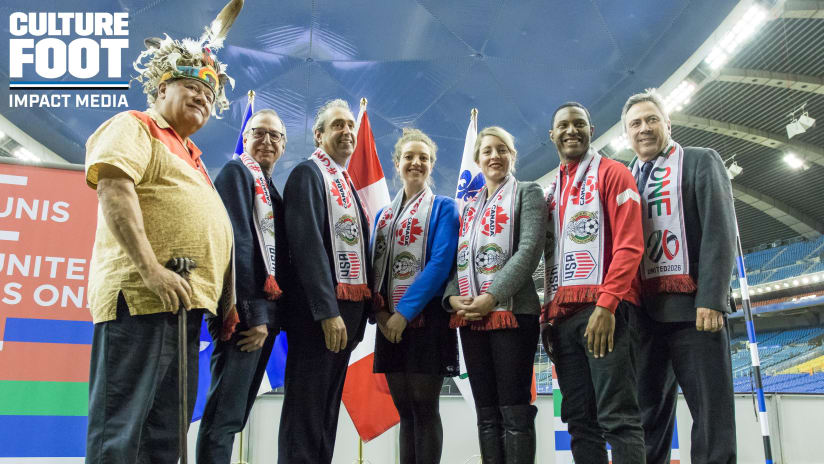The mysterious world of bidding for a FIFA World Cup has always been a hot topic. Almost everyone, soccer fanatics and the average fan alike, has an opinion on whether it’s a good idea to host the world’s biggest tournament. But what do we really know about World Cup bidding? Who votes on the winner? And most importantly, why has FIFA been accused of corruption and bribery in its handling of World Cup bids?
News coming out of Olympic Stadium, just a stone’s throw away from Montreal’s Stade Saputo, was very positive for soccer enthusiasts north of the border, particularly in Montreal, Edmonton, and Toronto. The Minister of Canadian Heritage, Mélanie Joly, announced that Montreal has agreed to host a share of World Cup games in 2026, if the united bid from Mexico, Canada, and the United States proves successful. Only one nation stands in the way: Morocco.
For the first time in the tournament’s history, 48 teams will qualify as opposed to the usual 32, which means the nation(s) that will host the World Cup will need to make sure they have the infrastructure to do so. The qualifying process is separated into two broad entities that make out the evaluation process: infrastructure and commercial elements.
Infrastructure: 70% of overall evaluation score
- Stadiums
- Accommodation
- Transport and mobility
Commercial: 30% of overall score
- Predicted costs
- Estimated revenue
Voting changes
But the main difference in the bidding process for 2026 is the actual vote itself. This isn’t the time to get into past FIFA scandals and corruption cases under former president Sepp Blatter. When Gianni Infantino took over the presidency in 2015, one of the main promises he made was to have more transparency in the bidding process, following the 2010 vote that led to the tournament being handed to Russia in 2018, and Qatar in 2022, in the midst of much controversy.
This may be one of the biggest changes to date in FIFA’s modern bidding process. The successful bidder was usually chosen with a vote by FIFA’s executive committee. The committee usually consisted of 20 and 30 FIFA executives, and more often than not, their votes were up for sale to the highest bidder, which is allegedly what happened during the 2018 and 2022 selection process. To fight this, Infantino changed the bidding process to allow every single FIFA member state to vote for who will get to host the World Cup.
With the host countries being exempt from the vote, and with Guatemala’s footballing association still serving a suspension, that makes 206 eligible votes. The successful bidder needs more than half the vote, meaning 104 to be exact. The logic being that everyone gets a say in who will host the tournament, but it also ensures that a corrupt vote will be much more difficult to achieve. The vote will also be transparent, meaning the public will have access to see who voted for which bidder, also in direct opposition to how the process was under Sepp Blatter.
To find the entire bidding process for the 2026 World Cup, click here.
A short history of World Cup bidding
The first version of the tournament was very different from what we’ve come to enjoy today. FIFA was started in 1904, as a footballing governing body to oversee a few of Europe’s soccer associations. Today, it comprises of 211 member states from every single continent.
The first country to ever host the tournament was Uruguay. A number of reasons made Uruguay the obvious choice: they were considered the superpower of the era, having also won Olympic gold two years prior, in 1928. They were also celebrating 100 years of independence in 1930, making it the perfect tournament to mark the occasion. That they would go on to win it makes it all the more special.
Only 13 teams competed in the tournament’s first edition, nine from South America, and only four from Europe. This is mainly due to two reasons: the three-week boat ride from Europe to South America didn’t seem worth it for most nations, but also because certain European countries were flustered that the tournament’s first edition wasn’t being held on the Old Continent.
The earlier editions of the most famous tournament in the world saw a lot of changes. The second World Cup in 1934 was the first one that implemented qualifying. 32 teams entered the race, with 16 teams qualifying for the finals in Italy. Uruguay, the defending champions, opted to not participate due to the lack of European teams present when they hosted just four years prior.
Of course, no World Cup would be hosted from 1938 until 1950, as most of the world was involved in World War II, making the hosting of a universal tournament a little difficult given the international tension.
The World Cup would continue to bounce between Europe and South America until 2002, when, for the first time in its history, it would be hosted in Asia, in a joint bid between South Korea and Japan. The two countries had bid for the tournament separately at first, meaning there were two separate organizing committees. This, combined with the fact that the two countries were quite far away from each other and had a long-standing rivalry, prompted FIFA to refuse united bids after 2002. Of course, FIFA eventually changed its ruling if the united bids featured only one organizing committee, which is the case with North America’s united bid.
Here is a quick look at every bid made since 1930 (except for countries that have only bid once):
<p>Germany</p> |
<strong>6</strong> |
<p>Argentina, Mexico, Morocco, Spain</p> |
<strong>5</strong> |
<p>Brazil, England, United States</p> |
<strong>4</strong> |
<p>Italy, Japan</p> |
<strong>3</strong> |
<p><strong>Canada </strong><strong>(1986, 2006)</strong>, Chile, Columbia, France, Holland, Russia, South Africa, South Korea, Switzerland, Uruguay, Australia</p> |
<strong>2</strong> |
The vote to decide who will host the 2016 FIFA World Cup is set for June 13 in Moscow, a day before the 2018 FIFA World Cup kicks off with a game between the hosts, Russia, and Saudi Arabia.




